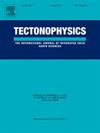Azimuthally anisotropic Rayleigh-wave phase-velocity maps of Europe
IF 2.6
3区 地球科学
Q2 GEOCHEMISTRY & GEOPHYSICS
引用次数: 0
Abstract
The European lithosphere is highly heterogeneous, with significant velocity contrasts across the continent. Despite its complexity, much of its detailed structure remains unexplored. We present azimuthally anisotropic phase-velocity maps of Rayleigh waves in the period range 4–40 s for Europe, derived from two years (2011−2012) of continuous waveform data from the Virtual European Broadband Seismic Network (VEBSN) and various temporary arrays. Using ambient-noise cross-correlation, we compute two-station dispersion measurements and integrate them into a tomographic inversion, simultaneously solving for isotropic and anisotropic structures through a least-squares approach. Our thorough suite of tests optimizes regularization and evaluates the resolution and trade-offs between isotropic and anisotropic anomalies. The phase-velocity maps at shorter periods reveal detailed images of major sedimentary basins, with the lowest velocities detected beneath the North German Basin, North Sea Basin, Rhone Basin, Po Plain, Pannonian Basin, and the Bay of Biscay. At longer periods, low-velocity anomalies are prominent beneath the Alps, Northern Apennines, Dinarides, and Anatolian Peninsula. Azimuthal anisotropy is also mapped in the shallow lithosphere, with fast axes in Southern Europe aligned parallel to mountain ranges such as the Pyrenees and Alpine-Apennine system. In Central Europe, the Tornquist-Teisseyre suture zone marks a transition between two domains of different anisotropic structures, suggesting “frozen-in” fabrics originated before the continental collision. The level of detail of these new phase-velocity maps makes them suitable for joint inversion with different types of geophysical data and as starting models for other imaging methods such as full-waveform inversion.
欧洲方位各向异性瑞利波相速度图
欧洲岩石圈高度不均匀,整个大陆的速度差异很大。尽管它很复杂,但它的许多细节结构仍未被探索。我们展示了欧洲4-40秒周期范围内瑞利波的方位各向异性相速度图,这些图来自于虚拟欧洲宽带地震台网(VEBSN)和各种临时阵列的两年(2011 - 2012)连续波形数据。利用环境噪声互相关,我们计算了两站色散测量值,并将它们整合到层析反演中,同时通过最小二乘法求解各向同性和各向异性结构。我们全面的测试套件优化了正则化,并评估了各向同性和各向异性异常之间的分辨率和权衡。较短周期的相速度图显示了主要沉积盆地的详细图像,在北德意志盆地、北海盆地、罗纳盆地、波河平原、潘诺尼亚盆地和比斯开湾下方检测到的速度最低。在较长的时期内,低速异常在阿尔卑斯山脉、亚平宁山脉北部、迪纳里德斯山脉和安纳托利亚半岛下面很突出。方位角各向异性也被绘制在浅层岩石圈中,南欧的快速轴与比利牛斯山脉和阿尔卑斯-亚平宁山脉等山脉平行。在中欧,Tornquist-Teisseyre缝合带标志着两个不同各向异性构造域之间的过渡,表明“冻结”构造起源于大陆碰撞之前。这些新的相速度图的详细程度使它们适合与不同类型的地球物理数据联合反演,并作为其他成像方法(如全波形反演)的起始模型。
本文章由计算机程序翻译,如有差异,请以英文原文为准。
求助全文
约1分钟内获得全文
求助全文
来源期刊

Tectonophysics
地学-地球化学与地球物理
CiteScore
4.90
自引率
6.90%
发文量
300
审稿时长
6 months
期刊介绍:
The prime focus of Tectonophysics will be high-impact original research and reviews in the fields of kinematics, structure, composition, and dynamics of the solid arth at all scales. Tectonophysics particularly encourages submission of papers based on the integration of a multitude of geophysical, geological, geochemical, geodynamic, and geotectonic methods
 求助内容:
求助内容: 应助结果提醒方式:
应助结果提醒方式:


